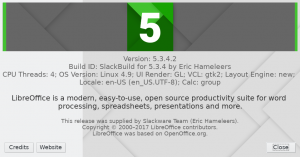 Slackware64 14.2 users will have to wait another day, but I have uploaded my latest set of Plasma 5 packages for Slackware-current to the ‘ktown’ repository. KDE 5_17.06 contains: KDE Frameworks 5.35.0, Plasma 5.10.2 and Applications 17.04.2. I based this new release on Qt 5.9.0 (at least for Slackware-current… for 14.2 I will stick to Qt 5.7.1).
Slackware64 14.2 users will have to wait another day, but I have uploaded my latest set of Plasma 5 packages for Slackware-current to the ‘ktown’ repository. KDE 5_17.06 contains: KDE Frameworks 5.35.0, Plasma 5.10.2 and Applications 17.04.2. I based this new release on Qt 5.9.0 (at least for Slackware-current… for 14.2 I will stick to Qt 5.7.1).
NOTE: I will no longer be releasing Plasma 5 packages for 32bit Slackware 14.2.
The move to Qt 5.9 meant that I had to recompile/update some of the packages in my regular repository as well, so if you look there, you will find the latest Calibre 3.1.1 which I based on Qt 5.9 as well (same story here: the Slackware 14.2 variant uses Qt 5.7.1).
What’s new in KDE 5_17.06?
- As said before, I moved to Qt version 5.9.0. This is supposed to be a LTS release (Long Term Support).
- As a result of the qt5 upgrade, lots of other packages in the ‘deps’ section were recompiled (grantlee phonon polkit-qt5-1 qca-qt5 qt-gstreamer qtav) or upgraded (OpenAL PyQt5 libdbusmenu-qt5 poppler qt5-webkit wayland).
- Plasma was updated to 5.10.2 bugfix release, see https://www.kde.org/announcements/plasma-5.10.2.php . And if you want to know more about what’s new in Plasma 5.10, read it on https://www.kde.org/announcements/plasma-5.10.0.php .
I compiled plasma-nm against openconnect so that it picks up support for it. However I did not add openconnect to the ‘deps’ section, you need to install it separately if you need it.
- Frameworks 5.35.0 is a maintenance release, see https://www.kde.org/announcements/kde-frameworks-5.35.0.php .
- Applications 17.04.2 is a bugfix update for KDE Applications 17.04. See https://www.kde.org/announcements/announce-applications-17.04.2.php .
- In applications-extra the following packages were upgraded: digikam, krita, kpmcore, partitionmanager. Calligra (for slackware-current) was recompiled against the new gsl, marble and qt5 libraries.
This upgrade should be relatively straightforward if you already have Plasma 5 installed. See below for install/upgrade instructions. For users who are running slackware-current, the most crucial part is making sure that you end up with Slackware’s packages for ‘libinput‘ and ‘libwacom‘. I had those two packages in the ‘current’ section of my repository for a while (they are still part of the ‘14.2’ section) but Slackware added them to the core OS. Failing to install the correct (i.e. Slackware) packages, may render your input devices (mouse and keyboard) inoperative in X.Org.
Non-ktown packages you probably want anyway
There are a couple of *runtime* dependencies that I did not add to the ‘ktown’ repository, but you may want to consider installing them yourself because they enable functionality in Plasma 5 that you would otherwise miss:
- vlc: will give phonon another backend to select from.
- freerdp: access RDP servers through krdc.
- openconnect: provides support for Cisco’s SSL VPN
All of the above can be found in my regular package repository.
In order for kdenlive to reach its full potential, you might want to consider replacing Slackware’s ‘ffmpeg‘ package by my version with extended functionality: more supported codecs including AAC and H.264 encoders.
Multilib considerations
If you install a 32bit program on a 64bit Slackware computer with multilib and that program needs legacy system tray support, you will have to grab the 32-bit version of Slackware’s ‘libdbusmenu-qt’ and my ktown-deps package ‘sni-qt’, and run the ‘convertpkg-compat32 -i‘ command on them to create ‘compat32’ versions of these packages. Then install both ‘libdbusmenu-qt-compat32‘ and ‘sni-qt-compat32‘.
Those two are mandatory addons for displaying system tray icons of 32bit binaries in 64bit multilib Plasma5.
Installing or upgrading Frameworks 5, Plasma 5 and Applications
You can skip the remainder of the article if you already have my Plasma 5 installed and are familiar with the upgrade process. Otherwise, stay with me and read the rest.
As always, the accompanying README file contains full installation & upgrade instructions. Note that the packages are available in several subdirectories below “kde”, instead of directly in “kde”. This makes it easier for me to do partial updates of packages. The subdirectories are “kde4“, “kde4-extragear“, “frameworks“, “kdepim“, “plasma“, “plasma-extra“, “applications“, “applications-extra” and “telepathy“.
Upgrading to this KDE 5 is not difficult, especially if you already are running KDE 5_17.05_02. You will have to remove old KDE 4 packages manually. If you do not have KDE 4 installed at all, you will have to install some of Slackware’s own KDE 4 packages manually. Luckily, KDE 5 is mature enough that there’s almost nothing left from old KDE 4 that you would really want.
What I usually do is: download all the ‘ktown’ packages for the new release to a local disk. Then run “upgrade –install-new” on all these packages. Then I check the status of my Slackware-current, upgrading the stock packages where needed. The slackpkg tool is invaluable during this process of syncing the package installation status to the releases.
Note:
If you are using slackpkg+, have already moved to KDE 5_17.05_02 and are adventurous, you can try upgrading using the following set of commands. This should “mostly” work but you still need to check the package lists displayed by slackpkg to verify that you are upgrading all the right packages. Feel free to send me improved instructions if needed. In below example I am assuming that you tagged my KDE 5 repository with the name “ktown” in the configuration file “/etc/slackpkg/slackpkgplus.conf“):
# slackpkg update
# slackpkg install ktown (to get the newly added packages from my repo)
# slackpkg install-new (to get the new official Slackware packages that were part of my deps previously)
# slackpkg upgrade ktown (upgrade all existing packages to their latest versions)
# slackpkg upgrade-all (upgrade the remaining dependencies that were part of my repo previously)
And doublecheck that you have not inadvertently blacklisted my packages in “/etc/slackpkg/blacklist“! Check for the existence of a line in that blacklist file that looks like “[0-9]+alien” and remove it if you find it!
Recommended reading material
There have been several posts now about KDE 5 for Slackware-current. All of them contain useful information, tips and gotchas. If you want to read them, here they are: http://alien.slackbook.org/blog/tag/kde5/
A note on Frameworks
The KDE Frameworks are extensions on top of Qt 5.x and their usability is not limited to the KDE Software Collection. There are other projects such as LXQT which rely (in part) on the KDE Frameworks, and if you are looking for a proper Frameworks repository which is compatible with Slackware package managers such as slackpkg+, then you can use these URL’s to assure yourself of the latest Frameworks packages for Slackware-current (indeed, this is a sub-tree of my KDE 5 repository):
The same goes for Frameworks for Slackware 14.2 (change ‘current’ to ‘14.2’ in the above URLs).
Where to get the new packages for Plasma 5
A Plasma5 Live ISO image will follow shortly on http://bear.alienbase.nl/mirrors/slackware-live/latest/ in case you want to try it out first (check the timestamp of the ISO on the web page).
Package download locations are listed below (you will find the sources in ./source/5/ and packages in /current/5/ and /14.2/5/ subdirectories). If you are interested in the development of KDE 5 for Slackware, you can peek at my git repository too.
Using a mirror is preferred because you get more bandwidth from a mirror and it’s friendlier to the owners of the master server!
Have fun! Eric
 After I released KDE 5_17.06 (June edition of my Plasma 5 package set) for Slackware 14.2 and -current a few days ago, I have now also uploaded an ISO image for the Slackware Live PLASMA5 Edition based on liveslak 1.1.8.1 and Slackware-current dated “Mon Jun 26 20:36:18 UTC 2017“. It will be the only Live variant this time,
After I released KDE 5_17.06 (June edition of my Plasma 5 package set) for Slackware 14.2 and -current a few days ago, I have now also uploaded an ISO image for the Slackware Live PLASMA5 Edition based on liveslak 1.1.8.1 and Slackware-current dated “Mon Jun 26 20:36:18 UTC 2017“. It will be the only Live variant this time,

 Slackware64 14.2 users will have to wait another day, but I have uploaded my latest set of Plasma 5 packages for Slackware-current to the ‘ktown’ repository. KDE 5_17.06 contains: KDE Frameworks 5.35.0, Plasma 5.10.2 and Applications 17.04.2. I based this new release on Qt 5.9.0 (at least for Slackware-current… for 14.2 I will stick to Qt 5.7.1).
Slackware64 14.2 users will have to wait another day, but I have uploaded my latest set of Plasma 5 packages for Slackware-current to the ‘ktown’ repository. KDE 5_17.06 contains: KDE Frameworks 5.35.0, Plasma 5.10.2 and Applications 17.04.2. I based this new release on Qt 5.9.0 (at least for Slackware-current… for 14.2 I will stick to Qt 5.7.1). In Slackware-current we use version 7.1.0 of the gcc compiler suite. These advanced compilers can sometimes be quite a bit more strict about what they accept as valid code. As a consequence, you will regularly run into compilation issues with software. Not just the software made with the scripts on
In Slackware-current we use version 7.1.0 of the gcc compiler suite. These advanced compilers can sometimes be quite a bit more strict about what they accept as valid code. As a consequence, you will regularly run into compilation issues with software. Not just the software made with the scripts on 
Recent comments